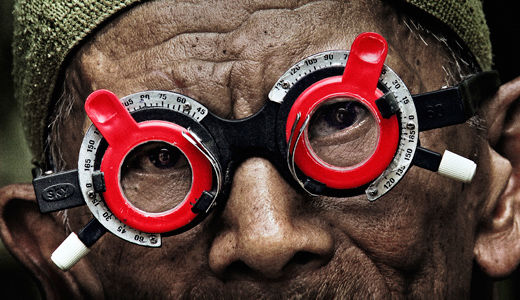
DURHAM, N.C. – Following up on the 2015 Full Frame Documentary Film Festival that took place here Apr. 9-12, we have covered human interest and environmental stories, and now we look at three films addressing the U.S. role in a number of Asian countries.
Joshua Oppenheimer has done a remarkable project concerning the 1965 massacre of an estimated one million very loosely defined “communists” in Indonesia at the direction of the newly installed military rulers. In his 2012 film The Act of Killing, he concentrated on the perpetrators of this wave of genocide, and now, in The Look of Silence, 50 years after the fact, he recalibrates his focus on society’s attempt to come to terms with this horrific period.
The story centers around Adi, an optometrist, whose older brother Ramli was killed in that episode, as he goes about questioning the ways in which various village leaders, and even members of his own family, collaborated in brutal acts of mass murder. Sometimes he corners his witnesses in optical lenses as he fits them for new glasses.
What Adi encounters is a society driven to denial and forgetfulness in a contemporary Indonesian climate of fear and intimidation. The wholesale murder of a million of their own fellow citizens must be justified – politically, socially, culturally, ethnically, religiously – any way possible, and ways are readily found. The episode has been turned into a foundational national historical patrimony, taught triumphantly to schoolchildren.
It takes a lot to shock a film audience today, but the casual, proud defense of killing people because they didn’t pray, or for some other far less than felonious reason (like wanting to unionize), can make a filmgoer wonder just what kind of people we have in this world. Some of the killers captured on film truly seemed to enjoy reenacting the sadism of butchery and slaughter in which they participated as young men. One even published a book about his vicious fling with murder, with his own sketches “to bring the story to life.” Several mentioned they had to drink cups of the victims’ blood so they wouldn’t go crazy, an anthropological custom that likely predates the establishment of Islam in the Indonesian archipelago.
One can only think of the much more familiar saga of the Nazi-sponsored Holocaust in the 1930s and ’40s for a comparable lesson in relativistic morality.
Scant remorse or repentance has taken place in the ensuing years. Indonesia is in desperate need of a “truth and reconciliation” movement (hey, I know, a lot of countries are), but under the present reigning ideology, it is nowhere in sight. The fact that Adi is a professional devoted to improving and correcting people’s vision is perhaps an accident of filmmaking, but it certainly resonates with the quest to open up that era to objective scrutiny. His mother, still alert in her 90s, believes the killers will be punished with eternal suffering in the afterlife.
More than once in the film the U.S. role in this history comes up. Oppenheimer replays a 1967 American TV broadcast that openly celebrates the liquidation. Now, the narrator proclaims, “Bali is more beautiful without communists.” The same broadcast highlights Goodyear’s rubber plantations in the country, where employees who wanted to unionize are now working as prisoners. In 1967 the connection between genocide and Goodyear in the same news story might have sounded coincidental, but at the distance of almost half a century it is all too transparent.
One successful and wealthy politician recalls eliminating communists day and night for three months, some 500-600 people at a time – the rivers ran red – while the military waited on the road to cart away the prisoners. He says he should be offered a free trip to the U.S. “because America taught us to hate communists…. If you do good, you’re rewarded.” That was, after all, the decade of Vietnam, the military coup in Brazil, invasion of the Dominican Republic, LBJ.
The Look of Silence is a quietly screaming act of witness, one among many documentaries proving that the very act of filmmaking is a risky, brave business, doing the work a free press ought to be doing on a daily basis, but doesn’t. Adi asks questions, appeals for some gesture of remorse, and is answered with threats: “If you keep making an issue of the past it will happen again,” says one deeply compromised legislator. Another killer accuses Adi of communist activity just for this unwelcome interrogation into history. Adi’s long silent stares show him trying to absorb the enormity of the denial he is hearing, as if ruminating to himself, How am I supposed to understand these people, much less judge them?
The credits list an anonymous co-director and many anonymous members of the film crew. Truthtelling is dangerous.
Director Patricio Henríquez gives us Uyghurs, Prisoners of the Absurd, an interview-format exposé of what could legitimately be called a “Catch 22” situation.
Twenty-two Uyghurs, from a Turkic ethnic minority in Western China, fled their homeland seeking religious freedom, deeper Islamic education and ethnic identity in neighboring Pakistan and Afghanistan. They were minding their own business and struggling, like any immigrants, to re-establish themselves in a new, unfamiliar land, when 9/11 struck half a globe away.
Shortly, Secretary of Defense Donald Rumsfeld held a press conference, excerpted in the film, announcing a generous program of financial rewards for Al Qaeda militants and perpetrators. “Leaflets dropping like snowflakes” promised $$$ for ransomed prisoners. What in time became a couple of thousand men held at Guantánamo included these 22 shackled and tortured Uyghurs, who barely spoke any of the languages of their fellow accused. They could not fathom how they managed to escape oppression in China, only to be treated so brutally, by the Americans, as “enemy combatants” – which, by the way, is not a recognized status under international law.
In this Kafkaesque tale of bureaucracy gone berserk, it becomes apparent before very long that these guys were neither terrorists nor guilty of anything. There is no evidence to cite against them. But the famous wheels of justice grind exceeding slow, and they languished at Guantánamo for years before they could be released. President Obama’s pledge to close the prison went unfulfilled, as Republicans gesticulated wildly about admitting “terrorists” onto U.S. soil – even if held at maximum security prisons – but essentially to deny them constitutional rights that the government interprets as not applying to the base on Cuban territory.
As the tale unfolds the lawyers and translators appear, U.S. pro bono advocates who themselves are dumbfounded by the lack of constitutionality away from our shores. The Uyghurs repeatedly receive assurances that someone cares about them, they’ve not been forgotten, and they will be released some day. All the while, on the world stage, Chinese spokespersons continue to demand extradition for the 22, believing them to be subversives and renegades against the state.
Then the question became what countries would accept these men, and in the end a few places were found, far from their homes, families and communities, and with ambiguous legal status. A handful went to the Pacific nation of Palau, nominally independent but under the aegis of the U.S. eagle. Palau got a heap of payoff money to settle the Uyghurs, about which their lawyer quips, “It would have been a lot cheaper to bring them to Virginia.” The last of the Uyghurs left Guantánamo as late as 2013. There remain 122 prisoners altogether at the base, some for more than 12 years already.
The tragic odyssey of these 22 Uyghurs – the word “absurd” only scratches the surface of what happened to these men – has drastically transformed and perhaps in some cases ruined lives. The only form of “truth and reconciliation” for them comes in the form of a documentary film that will likely have no discernible impact on policy.
A slice of life in today’s Afghan National Army
Directed by Saeed Taji Farouky and Michael McEvoy, the front-line documentary Tell Spring Not to Come This Year gives us a slice of life in today’s Afghan National Army (ANA) now that the foreign troops have left. The filmmakers courageously embedded themselves into a unit of poorly equipped, ill-trained, and only occasionally paid troops in Helmand province, who are trying to keep the Taliban at bay with a lot of Vietnam War-era surplus weapons. A viewer comes away unconvinced of their success.
We get a collective portrait of men at war, a classic theme in and of itself, with all the bravery, sacrifice, danger, as well as boredom, chaos and testosterone a viewer might expect. The film has a mesmerizing “you are there” quality as the camera picks up the soldiers’ lives in the barracks and training camps, and on the battlefield. These are regular guys enjoying a smoke or a quick soccer match who, owing to their poverty and joblessness, get caught up in supranational geopolitical and religious conflicts way beyond their control, with shifting, uncertain allegiances.
A few of the troops are singled out by the directors for greater attention, but the omniscient voiceover makes a montage of them all, usually failing to distinguish among them. Each one is an Everyman for the whole unit.
The local inhabitants, meanwhile, are caught between the two different wars being fought. “If the government would buy wheat at a good price,” says one farmer, “we wouldn’t grow opium.” Arms, money, roads and checkpoints seem to flow back and forth between Taliban and the regular army with dependable regularity, some by capture, others by corruption, and still others by financial and security arrangements that suit the warlords and the officer class. In some areas the tacit agreement is, “If you don’t attack us, we won’t go in.”
The film title suggests that if only spring wouldn’t come this year, the fighting season wouldn’t start up again. After almost a decade and a half, Afghans have gotten used to the cyclical nature of engagement with the insurgents.
The dominant feeling is one of abandonment by the American and Western allies, and at the same time a sense of relief that they are gone. They were only in the country for their own reasons, anyway. Now the Afghan army is “being asked to carry on a war that they never started in the first place,” said Saeed Farouky in the Q&A. Can the Afghans make a workable nation out of this place?
And at what cost? About thirty of the battalion featured in the documentary were killed during the filming. This sad, inconclusive artifact of today’s Afghanistan, neither predictive nor prescriptive, leaves all its questions suspended in the dusty maelstrom of battle, unanswered.
Photo: “The Look of Silence”











